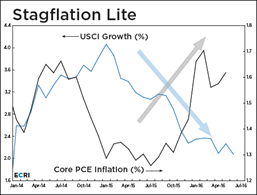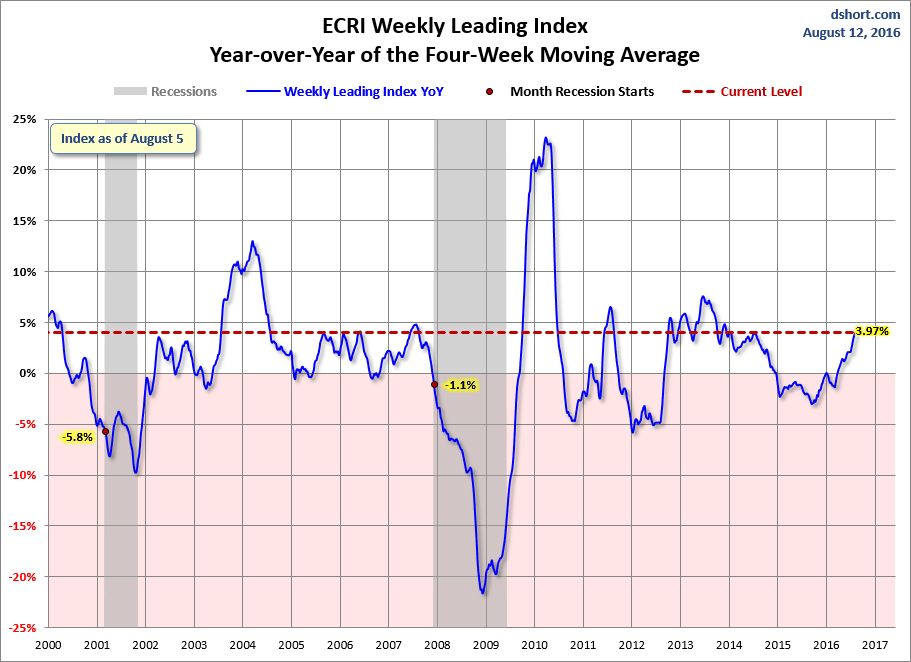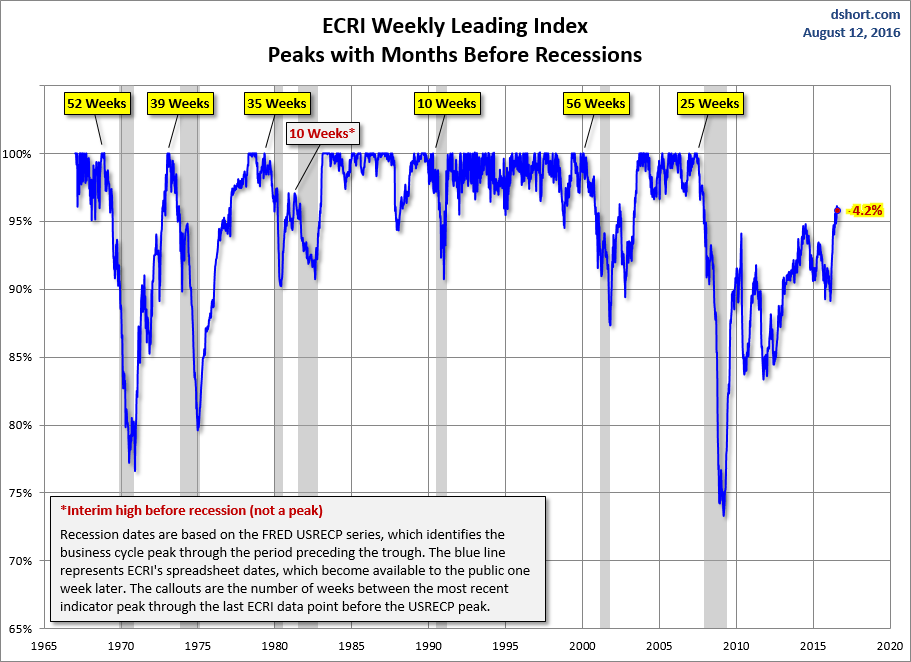ECRI Weekly Leading Index: “Key Measure of Cyclical Growth is Weakening”
October 23, 2015
Today’s release of the publicly available data from ECRI (Economic Cycle Research Institute) puts its Weekly Leading Index (WLI) at 130.0, up from 128.7 the previous week. The WLI annualized growth indicator (WLIg) is at -2.7, down 0.5 from the previous week, and well off its interim low of -4.7 in mid-January.
Key Measure of Cyclical Growth is Weakening
ECRI’s latest feature short commentary published earlier this week reemphasizes more of the same: a possible Fed rate hike is on a collision course with U.S. economic growth, which has been in a slowdown all year.
Here’s an excerpt:
Fed rate hike plans remain on a collision course with U.S. economic growth, which has been in a sustained slowdown all year.
That’s according to ECRI’s U.S. Coincident Index (USCI), a composite measure of aggregate output, employment, income and sales, which together define the business cycle.
Read the short article here.
The ECRI Indicator Year-over-Year
Below is a chart of ECRI’s smoothed year-over-year percent change since 2000 of their weekly leading index. The latest level is below where it was at the start of the last recession.
Appendix: A Closer Look at the ECRI Index
The first chart below shows the history of the Weekly Leading Index and highlights its current level.
For a better understanding of the relationship of the WLI level to recessions, the next chart shows the data series in terms of the percent off the previous peak. In other words, a new weekly high registers at 100%, with subsequent declines plotted accordingly.
As the chart above illustrates, only once has a recession ended without the index level achieving a new high — the two recessions, commonly referred to as a “double-dip,” in the early 1980s. Our current level is still off the most recent high, which was set back in June of 2007. We’ve exceeded the previously longest stretch between highs, which was from February 1973 to April 1978. But the index level rose steadily from the trough at the end of the 1973-1975 recession to reach its new high in 1978. The pattern in ECRI’s indictor is quite different, and this has no doubt been a key factor in their business cycle analysis.
The WLIg Metric
The best known of ECRI’s indexes is their growth calculation on the WLI. For a close look at this index in recent months, here’s a snapshot of the data since 2000.
Now let’s step back and examine the complete series available to the public, which dates from 1967. ECRI’s WLIg metric has had a respectable record for forecasting recessions and rebounds therefrom. The next chart shows the correlation between the WLI, GDP and recessions.
The History of ECRI’s 2011 Recession Call
ECRI’s weekly leading index has become a major focus and source of controversy ever since September 30, 2011, when ECRI publicly announced that the U.S. is tipping into a recession, a call the Institute had announced to its private clients on September 21st. Here is an excerpt from the announcement:
Early last week, ECRI notified clients that the U.S. economy is indeed tipping into a new recession. And there’s nothing that policy makers can do to head it off.
ECRI’s recession call isn’t based on just one or two leading indexes, but on dozens of specialized leading indexes, including the U.S. Long Leading Index, which was the first to turn down — before the Arab Spring and Japanese earthquake — to be followed by downturns in the Weekly Leading Index and other shorter-leading indexes. In fact, the most reliable forward-looking indicators are now collectively behaving as they did on the cusp of full-blown recessions, not “soft landings.” [Read the report here.]
Year-over-Year Growth in the WLI
Triggered by another ECRI commentary, Why Our Recession Call Stands, here is a snapshot of the year-over-year growth of the WLI rather than ECRI’s previously favored method of calculating the WLIg series from the underlying WLI (see the endnote below). Specifically the chart immediately below is the year-over-year change in the 4-week moving average of the WLI. The red dots highlight the YoY value for the month when recessions began.
The WLI YoY is in the negative zone, now at -2.4%, down 0.2 from last week. The latest level is lower than at the start of five of the last seven recessions. This indicator has only rarely dipped below its recent interim low outside recessionary periods: Lower levels occurred in 1988 and also during the economic volatility following the last recession









